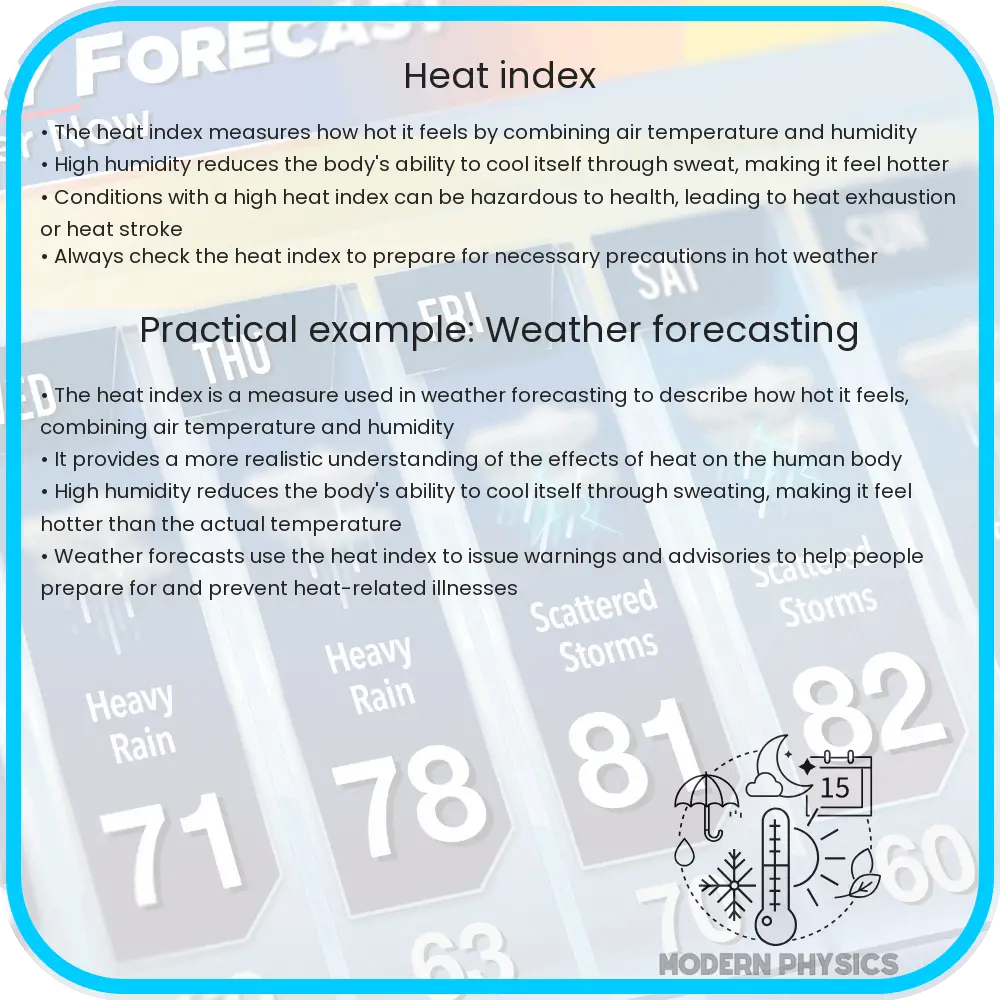The heat index is a measure that combines air temperature and relative humidity to reflect how hot it feels to the human body.

What is the Heat Index?
The heat index, often referred to as the “apparent temperature,” is a measure that combines air temperature and relative humidity to determine how hot it feels to the human body. This value is crucial because it provides a more accurate reflection of the body’s potential heat stress environment compared to air temperature alone.
How is the Heat Index Calculated?
The calculation of the heat index is not straightforward and involves a complex formula. Originally developed by George Winterling in 1978 and later adapted by the National Weather Service (NWS), the formula incorporates both the air temperature (T) and the relative humidity (RH) to produce the heat index (HI) in degrees Fahrenheit. The equation used is:
HI = -42.379 + 2.04901523*T + 10.14333127*RH – 0.22475541*T*RH – 0.00683783*T2 – 0.05481717*RH2 + 0.00122874*T2*RH + 0.00085282*T*RH2 – 0.00000199*T2*RH2
This equation, however, applies only under specific conditions, typically when the relative humidity is above 40% and the air temperature is above 80°F (approximately 27°C).
Measurements and Tools
To determine the heat index, you can use a simple weather thermometer to measure the air temperature and a hygrometer to assess the relative humidity. Many modern weather stations provide direct readings of the heat index by using on-board sensors and embedded algorithms based on the formula mentioned above. For convenience, there are also numerous online calculators and mobile apps designed to calculate the heat index by just entering the temperature and humidity.
Safety Tips related to the Heat Index
- Stay Hydrated: High heat index values can lead to dehydration. It’s crucial to drink plenty of fluids, preferably water, to help your body sweat and maintain a normal body temperature.
- Seek Shade or Air Conditioning: During the hottest parts of the day, stay in shaded areas or indoors in an air-conditioned environment to minimize heat exposure.
- Wear Appropriate Clothing: Light-colored, loose-fitting clothes are advisable as they reflect heat and allow your body to cool more efficiently.
- Limited Exposure: Limit exercise or strenuous activities to cooler parts of the day, such as early morning or late evening. If you must be active during heat advisories, take frequent breaks to cool down.
Impact on Health and Well-being
Understanding and monitoring the heat index is vital for preventing heat-related illnesses such as heatstroke, heat exhaustion, and heat cramps. Heatstroke is the most severe form of heat illness and requires immediate medical attention. Symptoms may include confusion, altered mental states, slurred speech, loss of consciousness, and hot, dry skin. By paying attention to the heat index, individuals can take proactive steps to manage their activities and environment, thereby mitigating the risk of such health issues.
Educational and Regulatory Importance
The concept of the heat index is not only a practical tool for individuals but also serves as a crucial component in workplace regulations and public safety strategies. Agencies such as the Occupational Safety and Health Administration (OSHA) in the United States utilize heat index guidelines to set advisory levels for workplace safety, ensuring that both employers and employees are aware of the potential hazards and necessary precautions during hot weather conditions.
Conclusion
The heat index is a critical measure that helps illustrate the dangers of hot weather by combining the effects of temperature and humidity. Thus, it provides a more comprehensive understanding of what the human body experiences beyond what the thermometer reads. By taking into account both air temperature and relative humidity, the heat index helps individuals, businesses, and healthcare providers make informed decisions about daily activities, safety precautions, and health care measures. Recognizing the significance and implications of this measure can substantially reduce the risks associated with high heat conditions, ensuring both personal safety and community well-being.
